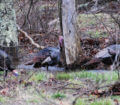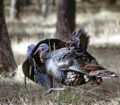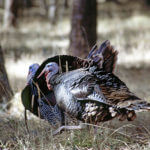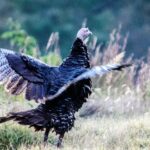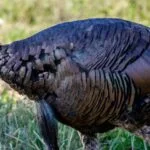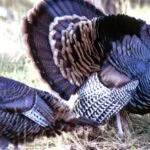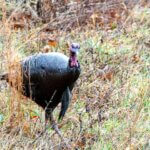John’s Note: Matt Van Cise of Brookville, Pennsylvania, has set the turkey-calling world on fire, winning the World Turkey Calling Championship, the Wild Turkey Bourbon Grand National Championship and other national and regional turkey-calling championships. Van Cise uses MAD calls, is a member of the Mossy Oak Pro Staff and loves to hunt wild turkeys.
Hunt Ready Turkeys:
I’ve been calling competitively since 1996 and hunting turkeys for almost 25 years. There are numbers of turkey hunters in Pennsylvania, and plenty of public lands where hunters can take wild turkeys here. Many Pennsylvania hunters can find 200,000 acres to hunt relatively close to home. The secret to hunting public lands is to not hunt in the most-obvious places, like many hunters do, and some turkey hunters hunt the same areas year after year.
Right now, our turkey population in Pennsylvania is very good. You can walk almost any ridge top or stop on any dirt road, call and hear a turkey gobble. Many hunters go to the same region and park in the same place every day they hunt. They leave their trucks there, walk into the woods and call the same way each day. I try to go into places where other hunters aren’t hunting by simply steering clear of other hunters’ vehicles. Each morning, I check different areas to find the most-aggressive turkeys. The turkeys gobbling the most are the gobblers that will come to a call. I don’t waste my time trying to take stubborn gobblers. I can take a stubborn bird, but I feel I’m most successful when I identify turkeys that want to come to a call on the day I’m hunting. I can come back and hunt the reluctant turkeys on another day.
People ask me what I’m doing to win all these world and national championships. Winning a championship is related to how you present the call. I spend time listening to wild turkeys, and I’ve developed a unique sound. I use the standard hen yell, but the sound I make is similar to a box call’s nasal sound. I use the MAD PreCision Plus (http://www.flambeauoutdoors.com/mad/), a diaphragm call with four reeds and a combination cut. (The call has a v-cut with one side of the v cut off). I believe this creates a much-prettier yelp on the front end of the call.
For me, a stubborn turkey is a gobbler that’s most often with hens. In my section of the country, most of a turkey’s strut zones are out in fields where hens have a better chance of hearing and seeing the gobblers strut, so they can go to him. If I have an opportunity to watch a turkey in a field the day before I hunt, I’ll try to get in that field early the next day. Most people set-up a blind on the edge of a field and then try to call the gobbler to them. But very rarely will you call that gobbler away from his hens. I’ll set-up my Primos Double Bull Blind (http://www.primos.com/) with Mossy Oak camouflage in a place where I believe the gobbler wants to be, usually the last place I saw that gobbler before he left the field. I use a realistic strutting gobbler decoy like the Flambeau King Strut (http://flambeauoutdoors.com/).
Some of those smart gobblers will fly down to the middle of the field and call the hens out of the woods right to the middle of the field. When I have to deal with a gobbler like this, I set-up my blind out in the middle of the field and put gobbler and hen decoys around it. I’ve never found that decoys prevent a gobbler from coming within gun range. Then I let the tom tell me how to call to him. If he’s gobbling, I’ll call as long as he’s answering. If he’s gobbling rarely, I just give him very-soft clucks and purrs. I try to determine what type of calling that gobbler will respond to on that day.
I often have to hunt turkeys that have experienced hunting pressure. To take those gobblers, I get as close as I possibly can while the gobbler is still on the roost. I want to get to that bird before any-other hunter has the opportunity. I harvest many of my Pennsylvania turkeys within 5 minutes of the turkey hitting the ground in the morning. Sometimes I set-up my blind right-under the gobbler’s roost tree. To get that close to a turkey, I watch him the night before I plan to hunt. Then I can see where he’s flying up to roost. I go to the roosting spot at least an hour before daylight. I set-up my blind underneath the turkey, set out some decoys and wait for daylight. As long as the night is pitch dark, I can get away with getting in that close. The sounds of setting-up the blind and the decoys don’t seem to spook the turkey, but I’m as quiet as I can be when I use this tactic.
If a turkey stays in the field until dark before flying up to roost, I probably won’t pinpoint the exact roost tree. I know a gobbler usually roosts within 50 yards of leaving the field, so I set-up my blind about 25 yards from the edge of the field in the direction the gobbler has flown. My success rate on getting close to the gobbler, setting up a blind and putting out decoys is almost 100 percent. Four times last season a hunter who was with me took a gobbler as soon as the bird’s feet hit the ground, or I took the gobbler just as his toenails touched down. Those four birds flew into the decoys and were standing within 10 yards of our blind.
I only use decoys when I’m hunting field gobblers. I’ve never used decoys in the woods. One of the toughest turkeys to take in the woods is a gobbler with hens. I’m sure you’ve read that to take this turkey you have to agitate and aggravate the boss hen with your calling. However, that tactic doesn’t often work. I just leave that bird alone when I know he’s with hens. I’ll come back and hunt him later in the morning or on another day. Often the gobbler will leave those hens at 10:00 or 11:00 am, and you’ll have a chance to call that bird.
I don’t waste much time hunting one turkey. I have hundreds of places I can hunt, so if a gobbler has hens or refuses to come to my calling, I back out of the woods and hunt another gobbler. I don’t like to put hunting pressure on the birds I’m trying to take. I’d rather find another turkey that’s gobbling and coming to me, instead of wasting the morning aggravating a gobbler I probably won’t be able to take. That’s what makes my hunting experiences different. Most hunters will continue to call a turkey, trying to get him to come in to the gun, even if that turkey doesn’t want to come. Some hunters say that when you call a gobbler over and over, and he won’t come to you, you’re educating that gobbler. I think the longbeard just gets bored with your calling and walks off. Instead of continually attempting to work a stubborn gobbler, you’ll be far more successful if you pick up and move. Go find another turkey that wants to come to your calling.
Some gobblers won’t respond to a turkey call. Maybe those turkeys have been shot at or wounded before, or perhaps they just don’t want to breed. I usually leave those birds alone. Instead of calling to tough turkeys, I prefer to spend more time scouting another turkey and finding the locations he frequents. When I put on my Mossy Oak camouflage and go into the woods to hunt a turkey, I spend more time hunting (learning all I can about a turkey’s habits) than I do calling to that turkey. Being proficient as a turkey caller has made me more successful as a turkey hunter, but I rely more on my woodsmanship and my hunting skills to get me where a turkey wants to be, rather than trying to call a gobbler in to where I want to hunt.
My strategy is to get as close to the gobbler as fast as I can when I hear him gobble. If a gobbler is talking to me, I want to take him quickly before he changes his mind. If I’m hunting later in the morning and that turkey answers my call with a gobble, I’ll start moving toward that bird. I call every 50 yards as I travel toward him. I want to get him so excited that he almost chokes himself gobbling. I want to convince him I’m a hen coming to him. Sometimes this tactic can bite you, and you’ll spook the gobbler. That’s happened to me. No tactic, strategy or calling technique will work every time you go turkey hunting.
 I’m in the woods often and moving through the woods regularly. I rely heavily on my Mossy Oak camouflage to keep the gobblers from seeing me. During the early season, I prefer to hunt with Mossy Oak Break-Up, because we don’t have a lot of green in the woods during the early season in Pennsylvania. Later in the season, when the trees and bushes start putting on fresh growth and sprouting green leaves, I prefer Mossy Oak Obsession that has more green in the pattern. I even camouflage my feet and legs by wearing LaCrosse (http://www.lacrossefootwear.com/) rubber boots with Mossy Oak camo on them. I also have a Mossy Oak hat, face net and gloves. The only parts of my body not covered in camo are my glasses and my eyes.
I’m in the woods often and moving through the woods regularly. I rely heavily on my Mossy Oak camouflage to keep the gobblers from seeing me. During the early season, I prefer to hunt with Mossy Oak Break-Up, because we don’t have a lot of green in the woods during the early season in Pennsylvania. Later in the season, when the trees and bushes start putting on fresh growth and sprouting green leaves, I prefer Mossy Oak Obsession that has more green in the pattern. I even camouflage my feet and legs by wearing LaCrosse (http://www.lacrossefootwear.com/) rubber boots with Mossy Oak camo on them. I also have a Mossy Oak hat, face net and gloves. The only parts of my body not covered in camo are my glasses and my eyes.
To learn more about turkey hunting, check out John E. Phillips’ print, Audible, Kindle and Nook turkey books at https://johninthewild.com/books/#turkey and at www.barnesandnoble.com. You also can download a free Kindle app that enables you to read the book on your iPad, computer or SmartPhone. Too, know more about calling turkeys by going to johninthewild.com/audio-files/ to purchase audio turkey tapes of Lovett Williams, Rob Keck and Chris Kirby, available for download to your SmartPhone, tablet or computer. For a free copy of John E. Phillips’ “The Turkey Gobbler Getter Manual,” go to https://johninthewild.com/free-books/ to download.

